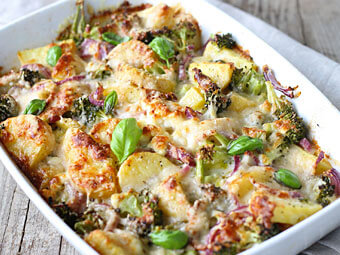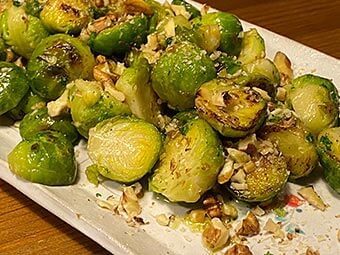
Brussels sprouts are a real vitamin bomb for the winter. Here you can find out how the healthy, vitamin-rich winter vegetable Brussels sprouts are properly prepared and how you can use a little trick to soften the cabbage taste.
The cut florets are greenish-white in color and have a diameter of 10 to about 40 mm. By the way, Brussels sprouts are biennials. If you don’t harvest all of the florets, they will sprout in the spring to form sprouts, which will then bear flowers in the summer.
Brussels sprouts, which are heavy feeders, prefer a very nutrient-rich and, if possible, sandy loamy soil. Good neighbors are potatoes, spinach, peas, celery and beetroot.
Table of contents:
- Cook Brussels sprouts properly
- Casserole with Kasseler
- Oat soup with Brussels sprouts
- Brussels sprouts in a Roman pot
- Brussels sprouts baked
- A little history about Brussels sprouts
- Prepare Brussels sprouts properly in German
- Now it's your turn, your support is needed
Cook Brussels sprouts properly
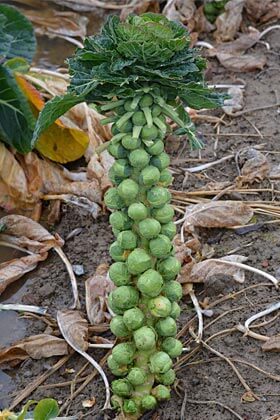
Cultivation focuses on the coastal areas of the Atlantic and North Sea in Great Britain, the Netherlands and France. Only around 10 percent of our requirements are covered by German production. Some early varieties can even be harvested from the beginning of September – but the actual harvest time is more likely in November and December.
In very cold areas, overwinter whole plants outdoors in a sheltered, shady plot. Brussels sprouts taste great in a salad and cooked as a vegetable and freeze well.
It contains many minerals and roughage as well as vitamin A, vitamin B2 and vitamin C. This makes Brussels sprouts a special fine vegetable with a very special nutritional value in the autumn and winter months. Incidentally, you pick the florets carefully from the bottom up from the stalk.
100 g Brussels sprouts contain approximately: 85 g water, 0.3 g fats, 387 mg potassium, 31 mg calcium, 22 mg magnesium and 112 mg ascorbic acid (vitamin C). The calorific value is around 151 kJ (36 kcal) – so super good for the figure!
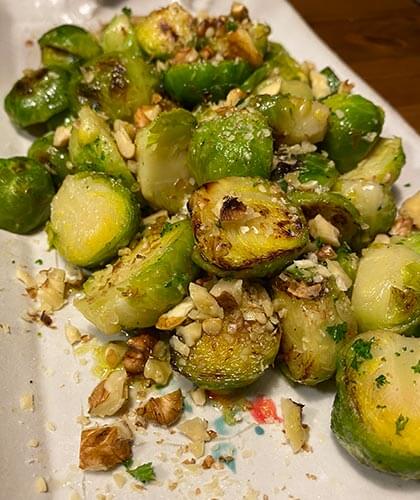
halved Brussels sprouts with walnuts and olive oil
Preparation: Clean the Brussels sprouts, removing the 2 to 3 outer leaves (our rabbits like to eat them) and the base of the stalk. By the way, I don’t cut it crosswise at the bottom. Why? We’ll get to that in a moment.
After cleaning, wash briefly in cold water, then steam in salt water – I always use an pot with a steamer insert You can also boil Brussels sprouts in water, but don’t “cover” them – that way they stay green: but please cook for just under 10 minutes so that the florets still have a bite.
My tip: Add a sip of milk and 1 to 2 teaspoons of sugar to the cooking water – then Brussels sprouts will not taste “bitter” either!
After the cooking time, I rinse the florets with cold water, so they keep their beautiful, light green color and don’t look so green-grey when overcooked. If brussels sprouts are to be served with meat or game, they are seasoned with nutmeg, sage, basil or lemon and doused with melted butter or cream.
Personally, I briefly fry the Brussels sprouts with a little butter in a good pan – add salt, pepper and some freshly grated nutmeg – done. Brussels sprouts can also be used in many types of casseroles, salads and even in savory cakes – if you like, you can even eat them with a simple pizza bread.
If the cell structure is damaged by cutting crosswise, sulphur-containing aroma compounds are formed together with enzymes. It is precisely these that provide the “Brussels sprouts scent”. This smell, which is not pleasant for everyone, develops more strongly the longer you cook the Brussels sprouts. The resulting aromatic compounds are also responsible for the slightly bitter taste of Brussels sprouts. But if, as already mentioned, you add a little milk and sugar to the cooking water, you can bring Brussels sprouts to the table a little more easily.
By the way, Brussels sprouts are one of the low-carb vegetables and are an integral part of a healthy diet. It can be used to prepare many delicious, healthy meals. I’ve put together 4 of them for you.
Casserole with Kasseler
If you ever feel like a hearty casserole with meat from the oven, then then the following recipe is definitely something for you. All you need for 4 people is:
200 g dried apricots
125 ml good white wine
400 g chestnuts
750 g Brussels sprouts
400 g Kasseler
1 onion
2 tb butter
4 eggs
150 g grated cheese (possibly Gouda)
200 ml cream
50 g sesame
Salt
pepper
nutmeg
It is then prepared as follows: Soak the apricots in the wine. Rinse the chestnuts well, cut them in, boil them in water for about 10 minutes and then peel them. Clean Brussels sprouts as described above, wash, cut into stalks. Cook in plenty of salted water or in a steamer basket for about 8 to 10 minutes. Drain and quench with cold water. Now preheat your oven to 180 degrees. Now wash the Kasseler, pat dry and dice. Now you can peel the onion and chop it finely. Sauté pork chops and onions in butter. Drain the apricots, but please reserve the wine. Mix eggs with approx. 100 g cheese, cream and wine. Season with salt, pepper and nutmeg. Layer the Brussels sprouts, apricots, Kasseler and chestnuts in a casserole dish. Pour the prepared sauce over it, sprinkle with the remaining cheese and sesame seeds and bake in the oven, covered, for 45 minutes. You can then garnish the whole thing with a little lemon balm. Good Appetite.
Oat soup with Brussels sprouts
The whole thing not only sounds healthy – it is! All you need for oat soup with Brussels sprouts:
300 grams of Brussels sprouts
3 tablespoons oatmeal (porridge)
1 small stick of fresh leeks
1 potato
1 small parsnip (or a parsley root)
2 tablespoons good butter
1 tablespoon finely chopped parsley
1/2 tsp salt
Cover and cook the oats in 3/4 l of water for a good 5 minutes. Wash and trim the Brussels sprouts, cut in half lengthways and cook together with the oats for another 5 minutes. In the meantime you can wash, clean and cut the leeks into small pieces. Peel, wash and finely dice the potatoes. Peel and finely dice the parsnip or parsley root. Add the vegetables to the soup and cook for another 5 minutes. Remove the soup from the heat, fold in the butter and parsley and season with salt to taste. Good Appetite.
Brussels sprouts in a Roman pot
Brussels sprouts can also be prepared in the Roman pot. All you need is:
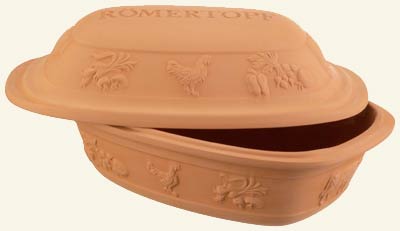 500 grams of Brussels sprouts
500 grams of Brussels sprouts
200 grams of millet
1/2 l vegetable broth
2 onions
3 tomatoes
good butter
2 tablespoons sour cream
nutmeg
pepper
Salt
Water the Roman pot. In the meantime, you can boil the millet in the broth and simmer or swell over low heat for about 20 minutes. In the meantime, preheat your oven. Clean the Brussels sprouts, dice the tomatoes and cut the onions into rings that are not too thick. Mix all the ingredients together carefully, place in the prepared Roman pot and spread the butter flakes over it. The whole thing is now in the oven at about 200 degrees for about 70 minutes. Now take the Roman pot out of the oven, fold in the sour cream and place the other Roman pot in the oven for 10 minutes. Before serving you can sprinkle everything with nutmeg and season with salt and pepper. Good Appetite.
Brussels sprouts baked
Of course you can also bake it. It’s not difficult and it’s delicious. For 2-4 people you need about:
750 g Brussels sprouts
Pepper salt
nutmeg
10 grams of butter
200 g crème fraîche
4 tablespoons white wine
1 egg
60 g Emmental cheese
30 g breadcrumbs
20 g flaked almonds
20 g butter flakes
Boil Brussels sprouts for about 10 minutes or steam until al dente. After draining the water, season with pepper, salt and nutmeg. Then add 10 g butter. Now fill it in a casserole dish. Put the crème fraîche in a bowl and stir in the white wine and the egg until smooth. Then the cheese is mixed into the crème fraîche. Now spread this sauce over the Brussels sprouts and sprinkle them with some breadcrumbs and flaked almonds.
Now distribute the small knobs of butter over the mixture and bake at 180 degrees for about 40 minutes until the crust has taken on a nice golden brown colour.
In short – after a good 30 hours you have conjured up a Brussels sprouts baked on the table.
A little history about Brussels sprouts
The first evidence of the cultivation of Brussels sprouts dates back to 1587. The original French name is Choux de Bruxelles. In German-speaking countries it was known as “Brussels sprouts” or “Brussels cabbage”. As early as the beginning of the 19th century, it began its triumphant advance as a winter vegetable throughout Europe and also spread to the USA. Today, however, it is mainly grown in the Netherlands, France and the United Kingdom.
Prepare Brussels sprouts properly in German
You can find this article in German at www.rolfkocht.de as “Rosenkohl richtig zubereiten – vitaminreich und gesund durch den Winter”
Now it's your turn, your support is needed.
Did you like the post "Prepare Brussels sprouts properly – rich in vitamins and healthy through the winter"?
Simply select the number of stars and click. Thank you very much for your review ![]()
You might also be interested in this
To the casseroles, get set, go! Quick casserole recipes for every taste
Now a casserole with a delicious crust on the table! It is probably the seductive scent, the countless possible variations and the simple preparation that make casseroles and gratins so popular with young and old. Sometimes with meat, sometimes vegetarian…




